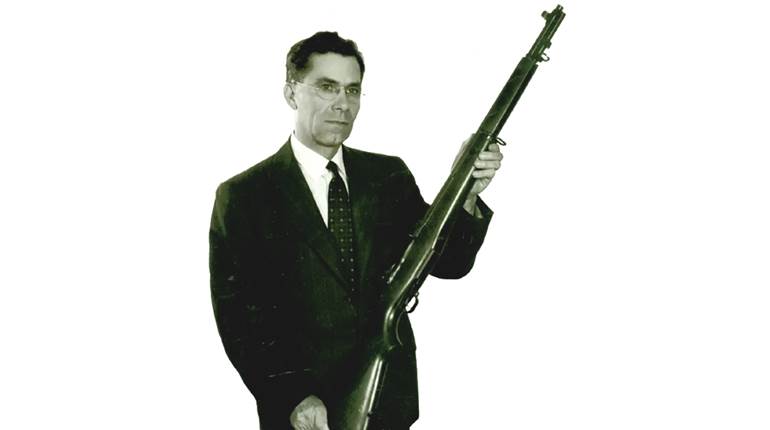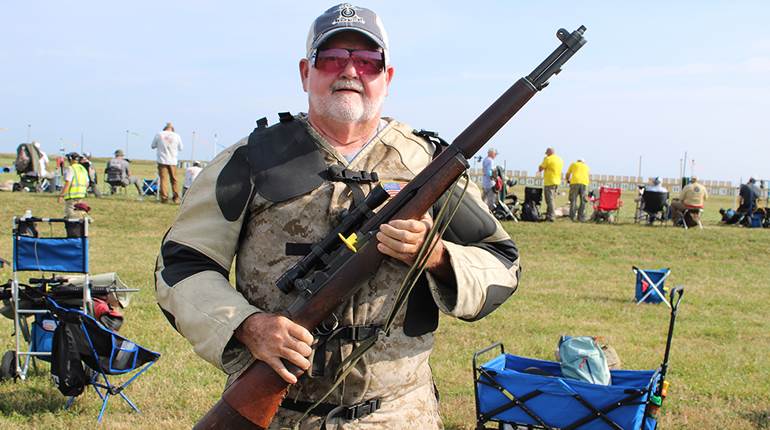
St. Jean le Baptiste Cantius Garand was a French-Canadian born near St. Rémi, Quebec in 1888. One of 12 children, his father moved the family to Jewett City, Conn., in 1898 after his wife died. Garand, who shortened and changed his first name to John not long after his immigration, worked in a textile mill—in the days before child labor laws—along with his siblings and learned English. As a lad he became fascinated with firearms after working for a short time in a shooting gallery. At the age of 21 he got a job with Bowne and Sharp, and learned the machinist trade. Fueled by his fascination of firearms and as a budding machinist, Garand dabbled in gunsmithing and design as a hobby. His passion became his vocation in 1917 when the War Department accepted his design for a light machine gun and hired him into the Bureau of Standards. Two years later Garand transferred to Springfield Armory as a designer.
There he worked on several machine gun projects, including the Model 1919 and a M1922, both of which were blowback designs. In 1928 the Semi-Automatic Rifle Board in a joint effort with the army, navy and Marine Corps set forth a trial to evaluate a new rifle for the military services. Rifles included the .276 Pedersen T1, an M1924 Garand and another rifle called the .256 Bang. By September of that year none of the contestants outshined the others, but for some reason Garand’s .30-caliber, gas-operated rifle was shelved from further competition. The following year the board invited Browning and Colt to submit candidates, along with examples from Holek (a Czech gunmaker), Pedersen, Rheinmetall (Germany) and Thompson. Garand’s design was also asked to resume in the tests, but chambered in a .276-cal. cartridge, the T3E2. One of Garand’s .30-cal. T1E1 rifles was also tested but failed with a cracked bolt.
In a January 1932 meeting the board recommended the .276 Garand T3E2 to be adopted, and put in an order for 125 copies for further testing. Garand had been working on a new design for the bolt in the .30-cal. T1E1 rifle and submitted it for retesting as well. Both rifles completed the tests successfully. Army Chief of Staff General Douglas MacArthur made a case for not changing to the new .276 cal., citing vast stores of .30-cal. M1 ball ammunition. Soon the word came down that research of .276-cal. ammunition world cease, and those efforts were redirected to assess and cure problems encountered in the .30-cal. Garand.
Trials continued with what was now called the T1E2 rifle, and in August of 1933 it became the Semi-Automatic Rifle, Caliber 30, M1. During the following two years a number of minor shortcomings were identified and addressed, and on January 9, 1936 the final standards for the M1 were established. The first M1 was proof tested on July 21, 1937. The first M1 rifles were delivered to the army in September 1937.
Early in the production, several issues were found with both design and production. These involved the barrel, gas cylinder and front sight assembly. By 1940 the problems were dealt with, including a recall of the early rifles to have them retrofitted with the improvements. At this time Springfield Armory was turning out about 500 rifles per day, and by the end of 1941 the army had been completely outfitted with the M1 rifle. As war broke out, Winchester was tapped to supply 65,000 more copies. When World War II ended, 5 1/2 million .30-cal. M1 rifles were produced.
The semi-automatic M1 soon owned World War II battlefields. Axis countries floundered with bolt-action, five-shot rifles, but the M1 not only offered faster firepower but three more rounds in its en bloc clips. Too, shot-to-shot recovery is much quicker with its semi-automatic action and a slight reduction in felt recoil due to its gas operation. This spurred those countries to rapidly develop and issue their own semi-automatics and machine guns. The M1 was—and remains—a robust and accurate rifle. Though a bit heavy, its reputation for putting an enemy down reliably and from a distance endeared it to soldiers and Marines throughout the war theater. General George S. Patton famously declared the M1 “the greatest implement of battle ever devised.”
Operation of the M1 is as simple as it is genius. The rifle is fed from an 8-round en bloc clip—originally designed and patented by John D. Pedersen in 1931. It is claimed that at the time the Semi-Automatic Rifle Board felt that a large opening in the bottom of the receiver for a detachable-box magazine would be too susceptible to contamination by dirt in the field.
A catch on the follower arm engages the operating rod which connects to the bolt. The operating rod controls the movement and locking of the bolt. When a full clip is inserted, the bottom of the clip engages the follower arm disengaging it from the operating rod, freeing it to move into battery under spring tension. As the bolt moves forward, it strips a round from the clip and slides it into the chamber via a feed ramp. Just before the round is fully seated, a locking lug on the bolt engages a cam on the operating rod that rotates the bolt clockwise from the rear into a recess on the operating rod, thus locking the bolt and preventing any rearward movement. Simultaneously, the extractor snaps over the rim of the cartridge, and the ejector plunger on the face of the bolt is pushed flush with the bolt face, compressing the ejector spring. When the bolt was retracted, an internal hammer engages a pair of hooks connected to the trigger lug. As the bolt rotates into battery, the firing pin also rotates out of a notch that prevents forward movement, thus freeing it to move forward when struck. When the trigger is pulled, the sear disengages from the trigger lug, allowing the hooks on the hammer to be freed, and the hammer drives the firing pin forward through the bolt to strike the primer.
The bullet is driven down the barrel; just prior to the muzzle is a port that taps some of the propulsion gases, activating a piston connected to the operating rod. As the rod is driven rearward, the bolt lug rides along about 5/16" before engaging a cam that rotates it out of the locked position and into its free position allowing the operating rod to move the bolt rearward, completing the cycle. The 5/16" of travel allows the bullet to leave the muzzle and the pressure to decay to a safe level before unlocking the bolt. When the last round is ejected from the rifle, a latch on the operating rod frees the en bloc clip, and an ejection spring throws the empty clip from the top of the receiver—the infamous “clink” that signaled an empty rifle.
World War II variants of the M1 included a sniper version, the M1C and M1D—basically a hand-assembled rifle to ensure accuracy which included provisions to mount a telescopic sight. These occurred late in the war, supplanting sniper versions of the 1903 Springfield, but the M1C saw considerable use in the Korean War. A few shortened M1s, the M1E5 and T 26, dubbed Tanker Models, were made but never saw service. They featured 18" barrels, and the M1E5 had a folding stock. Another late-war variant, the T20E2 variant was modified into selective fire and accepted 20-round BAR magazines. Only 100 of these were made, and none saw service. At least a couple of dozen other tool-room modified M1s were made, but the vast majority of them never saw the light of day outside the tool room.
An almost universal respect for the M1 by its users, as well as the recipients of its wrath ensured the rifle’s place in military history. After World War II, a program was undertaken to modernize the M1, resulting in the M14 rifle. Beretta added its own rendition calling it the BM59. Though some of the resulting offspring were capable of selective fire, it soon became apparent that full-auto in either the 7.62x63 or the 7.62x51 cartridges were too much to control in a rifle platform. Garands or Garand-based rifles nonetheless ruled the target shooters’ roost for decades until the advent of heavy bullets in the AR 15 platform.
The M1 has been used by nearly three dozen countries in various forms, including those captured on the battlefield and pressed back into service by the captors. Some 70-plus-year-old M1 rifles have even been captured from ISIS personnel on occasion. It is a testament to the durability and timeless design that an immigrant from Canada contributed to the United States more than 75 years ago.






































